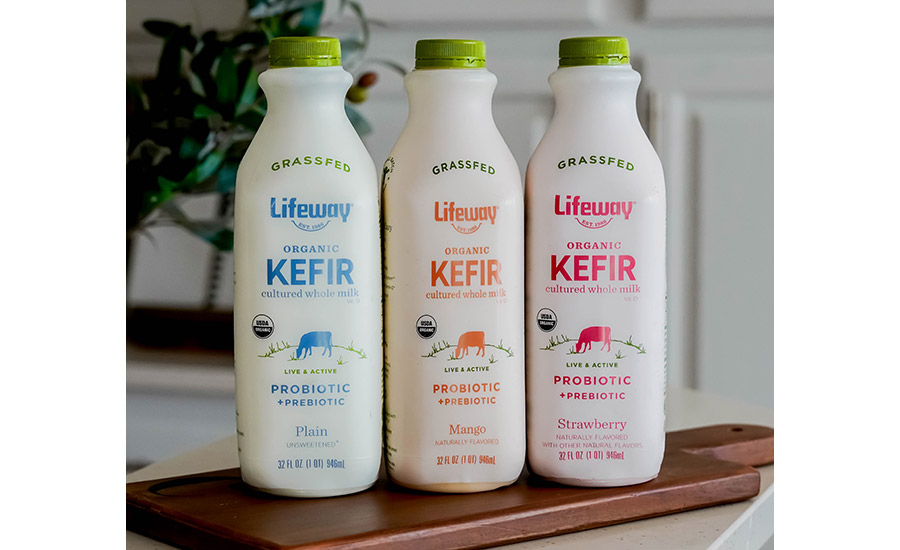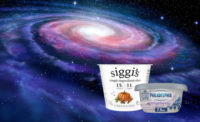Ingredient Issue: Cultured dairy ingredients crush the competition
Fermented ingredients rich in probiotics promote healthy digestive system.

Rennet is commonly used in manufacturing cheese, cottage cheese, and cream cheese and is vital for triggering coagulation.
Photo courtesy of A&B Ingredients.

Today’s health-conscious consumers are trying to live their best lives. As a result, they’re looking for functional foods and beverages that do more than fuel the body. Consumers are reading labels and discovering that cheese, yogurt, drinkable yogurt, kefir, and other fermented dairy products not only provide satiety but are proven to benefit digestive health.
“Cultured dairy ingredients, like probiotics and enzymes, have been experiencing increased demand due to their perceived health benefits and versatile applications,” states Kyra Appleby, innovation technologist at iTi Tropicals. At Expo West, the Lawrenceville, N.J., flavor company saw more products, both dairy-based and non-dairy based, promoting the use of probiotics to support consumers’ health.
The live bacteria and yeasts in probiotics are beneficial for one’s digestive system and are commonly found in yogurt, drinkable yogurt, and some dairy dips. Enzymes, on the other hand, are proteins that catalyze chemical reactions and are influenced by technological advancements, product innovations, and increased demand for natural and clean-label products, Appleby says.
One enzyme, rennet, is commonly used in manufacturing cheese, cottage cheese and cream cheese and is vital for triggering coagulation, she adds.
Yet, when it comes to initiating fermentation in cultured dairy products, starter cultures, a combination of bacteria/microorganisms, serve as inoculants for making fermented foods like yogurt.
IFPC’s An Ho, who directs food science and product innovation, notes that cultures, lactose and protein are important ingredients, with the St. Louis-based company providing stabilizing cultured dairy blends along with blends and flavors to support protein or fiber claims on label.
“Protein is huge in yogurt and cottage cheese. But sour cream and buttermilk are all about the texture and flavor,” Ho explains. “Kefir is also about the probiotics that can either come in live active cultures or yeast.”
Fermented dairy products, like probiotic-rich yogurt, are becoming a “dynamic category,” that has nearly doubled in volume over the last 20 years, states Joe O’Neill, vice president of sales and business development at A&B Ingredients, Fairfield, N.J.
“The global yogurt market is projected to reach sales of $199.7 billion by 2032,” he says, citing data from imarc impactful insights.
Peter Kempe, senior vice president for strategy and business development, Ingredients, for Nelson-Jameson, Marshfield, Wis., concurs that the popularity of yogurt and its drinkable offerings have seen a steady growth trajectory over the past two decades.
“[Yogurt] growth is following the overall trend in the food industry, i.e., approx. 3-4% YoY,” Kempe states. ”Cottage cheese has regained popularity during the pandemic, as a source of nutritious protein. Sour cream and buttermilk markets are rather flat. Kefir and niche items are gaining popularity.”
According to New Hope Network's 2024 Trends and Innovations Special Report, 41% of respondents plan to purchase products for digestive health, with similar interest in items promoting brain health, immunity, and inflammation.
Sugar reduction also is trending within cultured dairy, with 63% of consumers prioritizing lowering their sugar intake over sodium or fat, according to FMCG Gurus 2023 Active Nutrition Survey.
O’Neill points to upcoming regulations governing sugar levels in breakfast cereals, yogurt, and flavored milk in U.S. schools further emphasize the importance of reducing added sugars.
“This trend is driven by concerns about the association between high sugar consumption and chronic diseases,” O’Neill states. “In line with this, 32% of consumers agree that being ‘low in sugar’ is a marker of healthy foods, according to the International Food Information Council (IFIC) 2022 Food and Health Survey.”

Cultured dairy delights in growth
According to Mordor Intelligence, the cultured dairy market is projected to reach nearly $139 billion in 2024, with mounting growth of more than $166 billion by 2029.
In its “Dairy Cultures Market by End User (Cheese, Yogurt, Kefir, Others),” Portland, Ore.-based Allied Market Research reports that the global dairy culture industry generated $883.2 million in 2022 and is anticipated to generate nearly $1.5 billion by 2032, at a compound annual growth rate (CAGR) of 5.8%.
Report Prime predicts even larger growth for cultured dairy blends which is expected to grow from $2.4 billion in 2022 to $4 billion by 2030, at a CAGR of 6.5%.
“The increase of demand from consumers is their growing awareness of preventative care through their diet by purchasing healthier, probiotic and plant-based alternatives,” says Andrea Lee, junior marketing specialist at Flavorchem, Downers Grove, Ill.
Other factors also are contribution to the upswing in cultured dairy ingredients, according to iTi Tropicals’ Appleby. These include:
- Increasing consumer awareness of the health benefits associated with probiotics and fermented dairy products;
- Growing demand for natural and clean label ingredients;
- Expansion of the dairy industry into emerging markets where there is a rising preference for dairy-based products; and
- Technological advancements in food processing and biotechnology, enabling the development of new and improved cultured dairy products.
Noting that dairy products can play a significant role in supporting both gut and immune health by delivering a combination of probiotics, prebiotics, and essential nutrients, A&B Ingredients’ O’Neill points out that yogurt and kefir are top choices for delivering probiotics.
“They naturally contain live and active cultures such as Lactobacillus and Bifidobacterium, which can help maintain a healthy gut microbiome balance,” O’Neill explains. “Adding prebiotics, like inulin, to dairy products could deliver the symbiotic benefit of probiotic cultures and feed the good bacteria already present in the gut. We offer prebiotic fiber (inulin) from chicory root, which, along with plant-based probiotics, offers dairy manufacturers a great opportunity for product innovation with a focus on gut and immune support.
“Chicory fiber, a non-GMO prebiotic, enhances creaminess without altering taste, making it ideal for applications prioritizing mouthfeel,” he continues. “Additionally, it can help reduce offnotes from high-intensity sweeteners in reduced-sugar formulations.”
The company also offers high-quality plant proteins that provide nutritional and functional benefits in cultured dairy and alternative dairy products. These include Pisane pea proteins which can be added to formulations without compromising taste.
“The organoleptic qualities of these pea proteins have been optimized through a patented process to address the ‘green’ taste and offnotes. Our pea protein isolate is readily soluble and can improve the creaminess of products without adding fat,” O’Neill says.
Going nuts for coconuts
Also designed to reduce fat in products is iTi’s coconut cream, which is standardized to 24% fat and can be blended with water to reduce the overall fat percentage for a coconut milk product, Appleby states.
Coconut cream is naturally cholesterol-free, is low in sugar and carbohydrates, and has a smooth, creamy mouthfeel and a flavor that is not overly sweet. The mouthfeel of coconut cream is comparable to the mouthfeel of heavy whipping cream, although coconut cream has less fat than heavy whipping cream, according to Appleby.
“Coconut cream is a great substitute for dairy ingredients such as milk and heavy cream because it has a mild flavor and enhances flavor when combined with other ingredients,” she says. “Coconut water and dairy milk are both well known to be high in potassium, and coconut water makes a great addition to cultured dairy alternative formulas looking to fortify their potassium content to dairy type levels. Coconut water can also provide some additional mouthfeel and sweetness as well.”

More fermented dairy, please
Nelson-Jameson offers new yogurt cultures that create mild flavor profiles as well as cultures for bio-protection. The company also is taking measures toward sustainable and clean-label cultured dairy ingredients by replacing sorbate with cultures containing bioprotective properties, Kempe says.
To address the growing importance of clean-label products and natural ingredients, A&B Ingredients actively collaborates with customers to replace additives, stabilizers, and preservatives with natural alternatives.
“This shift aligns with consumer demand for more recognizable ingredients and ‘healthy’ labels, ensuring our cultured dairy ingredients meet the standards for clean-label products,” O’Neill states.
Flavorchem’s Lee notes that because consumers want to purchase more sustainable products, packaging also has had to evolve.
“Yogurt brands have been using a recyclable plastic, low-density polyethylene (LDPE), or glass as the top sustainable options According to Mintel, LDPE has had a nearly 200% increase from 2023 to 2024 while glass has seen an increase of 62%,” Lee states.
Packaging aside, clean-label ingredients are being marketed by most ingredient companies. “Our product line includes two coconut cream products composed of only coconut extract and water, and our coconut water concentrate consists solely of coconut water. You can’t get much cleaner than that,” Appleby notes.
Kempe notes that new cultured dairy products will continue to meet consumers’ needs for value and functionality and that more small companies are giving consumers farm-based, organic cultured products in spicy, savory, and fruity flavors.
He points out another interesting fact. “Most, if not all, large yogurt players have plant-based offerings, whereas most large cheese producers are not or are only limitedly active in the plant-based space.”
Looking for a reprint of this article?
From high-res PDFs to custom plaques, order your copy today!






